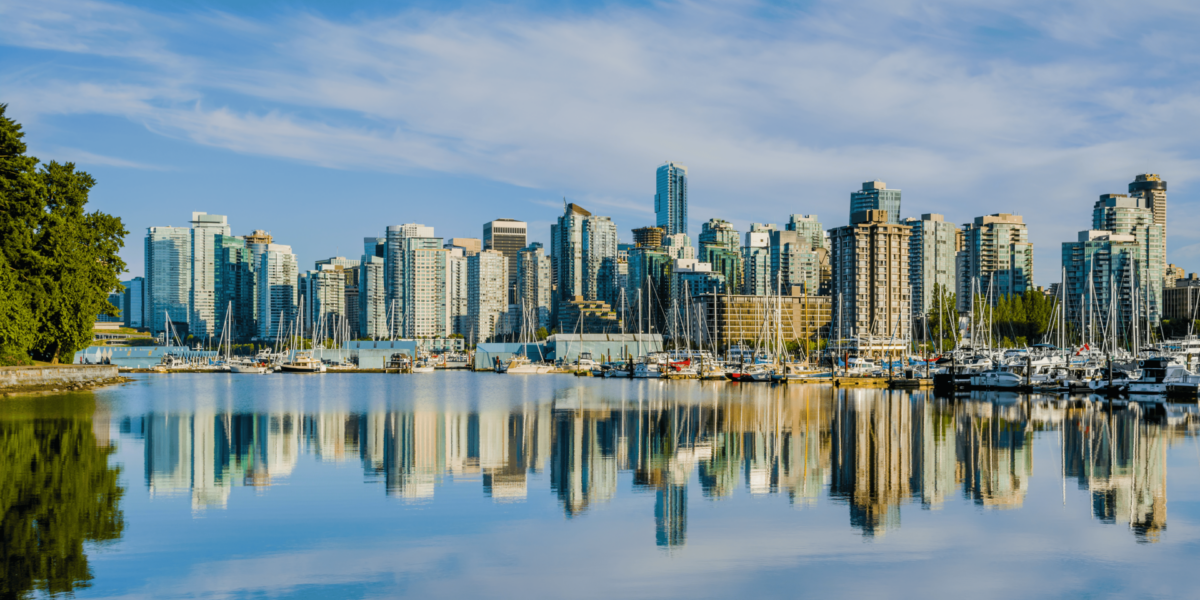Vancouver’s skyline stands out because of how it blends natural landscapes with modern design. The city’s glass buildings don’t block the view—they reflect it. The mountains, ocean, and sky all become part of the architecture.
Imagine walking through downtown just after sunrise. As light hits the high-rises, each panel of glass reflects the North Shore Mountains. These reflections shift throughout the day, turning buildings into moving mirrors of the natural world around them. This visual connection makes Vancouver’s skyline unique among major cities.
Glass Architecture Creates Dynamic City Views
Glass-covered buildings shape how people see the city. They capture the sky during the day, reflect city lights at night, and shift color with the weather. This creates a skyline that never looks the same twice.
In a realistic scenario, someone looks out from a downtown rooftop on a clear day. The city’s towers reflect deep blue skies and green forested ridges in every direction. The glass adds motion to the still structures, giving the skyline a sense of life that changes with every passing hour.
Natural Landmarks Enhance Urban Design
Vancouver’s location between mountains and water influences how the city is built. Architects and planners design with these views in mind. Tall buildings use glass not just for style, but to reflect the natural environment and reduce visual weight.
A person walking along False Creek sees towers rising behind the water. Each one seems lighter, almost blending into the background. This effect softens the city’s appearance and connects it more deeply to its natural surroundings. The skyline feels open, not overpowering, because the mountains remain visible between the structures.
Reflective Design Supports Environmental Awareness
Glass buildings in Vancouver do more than reflect beauty—they remind people of the environment’s presence. By mirroring the sky and terrain, the city’s skyline keeps nature in sight, even in the middle of dense development.
Picture someone commuting through downtown. With every glance at a building’s surface, they see clouds moving or trees swaying. These visual cues reinforce the city’s connection to the landscape and encourage a mindset that values preservation and balance.
Weather Adds Personality to the Skyline
Vancouver’s reflective skyline changes with the weather. When skies are clear, glass buildings echo the colors of the ocean and the mountain peaks. On cloudy days, reflections soften, making the skyline feel calm and quiet. Rain adds motion, creating patterns across the glass surfaces.
In daily life, a person sitting in a café might notice raindrops streaking down a tall building’s windows. These streaks, combined with the city’s gray tones, create a moody scene. That mood becomes part of the city’s personality—shaped not just by design, but by weather and atmosphere.
Reflections Shift with Time and Light
Light plays a major role in how Vancouver’s skyline appears. Morning reflections differ from evening ones. Sunlight changes angles, intensity, and color throughout the day, and the skyline transforms in response.
A resident looking out at dusk sees golden light hitting the west-facing towers. Reflections of the mountains soften into silhouette. As night falls, windows shift from reflecting nature to glowing with city life. This constant change makes the skyline feel more like a living system than a static image.
Photography Captures Vancouver’s Reflective Layers
Photographers are drawn to Vancouver’s reflective skyline because of how it holds and transforms light. Every shot becomes a record of both the city and its surroundings. The reflections tell a story not just about buildings, but about time, mood, and motion.
A photo taken during sunset from a high-rise balcony may capture clouds stretching across glass towers. Those same clouds, mirrored in the buildings, pull the viewer’s eye through the image. The result is a layered view that combines built form with nature’s design.
Urban Growth Respects Scenic Lines
Even with rapid development, Vancouver remains conscious of its sightlines. Regulations and design plans often aim to preserve views of the mountains and waterfront. Glass buildings help maintain these views by visually fading into the background during certain lighting conditions.
Someone working in an upper-floor office might have an unobstructed view of the mountains, even with nearby towers in place. Because of how glass interacts with light, the buildings don’t dominate the view. Instead, they reflect and support it. This approach allows growth without blocking the natural features that define the city.
Vancouver’s Skyline Reflects Its Identity
The reflective skyline is more than just an aesthetic choice—it reflects Vancouver’s identity. The city values clean design, environmental harmony, and visual openness. The use of glass and the emphasis on natural reflection align with these values.
As someone walks through downtown, they see more than buildings. They see the city’s relationship with land, light, and space. The skyline isn’t just what rises above—it’s how those structures echo the place they rise from.
A City Shaped by Reflection
Vancouver’s skyline does more than mark its place on a map. It mirrors the world around it. From mountains and ocean to shifting light and changing skies, the city’s reflective buildings invite people to look both outward and inward.
In this layered urban space, where glass meets granite and steel mirrors sky, design becomes dialogue. Vancouver’s skyline reminds us that cities can grow without losing their view—and that even modern structures can reflect something timeless.

